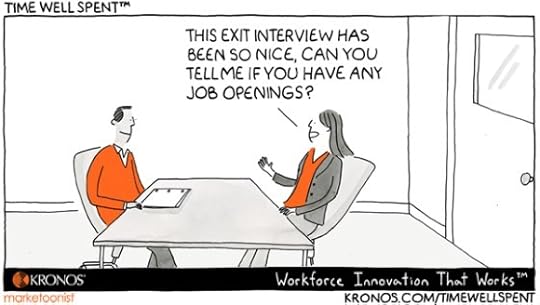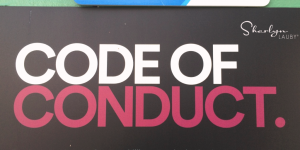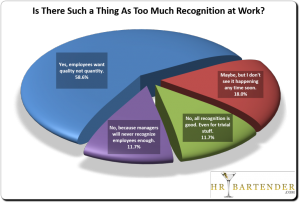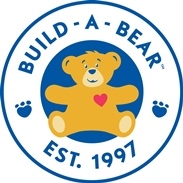Sharlyn J. Lauby's Blog, page 153
July 31, 2016
Company Telecommuting Policy Changes – Ask #HR Bartender
Policy changes can be emotional events as evidenced by today’s reader note.
I was a telecommuter for 10 years. After the company was sold, we were told that everyone living less than 60 minutes from the office can no longer telecommute. Of the 5 people that hold the same position as me, I am the only one who qualifies to no longer be a telecommuter.
The new company did not have a telecommuting policy but agreed to keep telecommuters providing they live far enough away. I lost 90 minutes of family time a day and feel slighted hearing from my co-workers how they work in their pajamas, go to the gym at lunch, pick their kids up from school, or run a quick errand during the day. Can employers make unwritten policies like, if you live near the office, you can no longer telecommute?
Kate Bischoff recently helped us answer another telecommuting question so I asked her if she would help with this one. Gratefully, she said yes. Kate is an attorney with the firm Zelle LLP in Minneapolis. Just a reminder that Kate’s comments should not be construed as legal advice or as pertaining to any specific factual situations. If you have specific detailed questions, they should be addressed directly with your friendly neighborhood labor attorney.
Kate, I know you’ve answered this before, but just to remind readers, there’s no law that requires employers to offer telecommuting – correct?
[Bischoff] Right. There is no affirmative obligation to allow employees to telecommute. It is a bummer for many, many employees, but still no requirement. This could change if telecommuting is a reasonable accommodation for the employee under disability laws.
Let’s talk briefly about the company sale. There are many employee issues that are mentioned in company sale documents, but I don’t believe policies like telecommuting would be one of them. When a company is sold, what should employees expect?
 [Bischoff] When a company is sold, employees are rightfully anxious about what is going to happen. Here’s what I can say is true at least 90 percent of the time – things will change. Even salaries and benefit options could be subject to change when a new entity takes over. It is rare when a sale does not affect the culture of the workplace.
[Bischoff] When a company is sold, employees are rightfully anxious about what is going to happen. Here’s what I can say is true at least 90 percent of the time – things will change. Even salaries and benefit options could be subject to change when a new entity takes over. It is rare when a sale does not affect the culture of the workplace.
Because telecommuters are part of the culture, telecommuting policies are subject to change. Heck, even a CEO change can lead to dramatic changes in telecommuting policies. My advice to employees is be patient. The changes will announce themselves. If the policy changes alter the culture to a place you don’t want to work any longer, there are other organizations looking for you.
In your experience, how do employers determine who gets to telecommute? Is it by position, distance to work, or something completely different?
[Bischoff] Whether an employee can telecommute is based on the position and the work of the position. For me, there are two main factors to determining if work can be done remotely.
Are there physical items involved in the position? A stocker at a grocery store, a server in a restaurant, or a factory worker who puts together widgets are not going to be able to telecommute and do their jobs.
Can performance expectations be set and monitored away from where the work is performed? If a regional sales manager is required to visit with and shadow her sales representatives twice a week, she is not going to be able work from home during those required visits.
All other concerns (or according to some, myths), like not being able to work collaboratively or build comradery among the team are quickly going away with the advent of collaborative tools and use of video. Technology has made telecommuting possible and will continue to make it easier.
On a few occasions, it may be necessary to revoke telecommuting. Most often, this happens when there is a performance issue where a manager needs to provide more individual, eyes-on supervision and training to an employee to improve productivity or work quality. When this happens the manager may request that the employee stop working from home and spend some time in the office under more direct and in-person supervision. If performance improves, telecommuting may again become an option.
If a company doesn’t have a telecommuting policy, can employees still telecommute? Is a policy required?
[Bischoff] No. I’m a lawyer, so I’m predisposed to write a policy, love a policy, and work the policy. But a telecommuting policy is not required. That said, policies help set employee expectations and give guidance that employees can use to ‘self-evaluate’ whether they can benefit under the policy. This guidance is a good thing because it sets a standard that can be uniformly applied across business units. (The other symptom of being a lawyer is a penchant for consistency.) But even if an employer does not have a policy, it can still offer employees telecommuting as an option.
The one thing I do recommend is when an employee is about to telecommute, work with the employee to set expectations and goals, and then monitor performance to those goals. While some employers use formal telecommuting agreements, all that is really necessary is clear communication about what is expected of a telecommuting employee for having the work arrangement be a success.
Finally, for those employees who are working in their pajamas and dropping off the kid’s lunch, can employers place “rules” on an employee’s workday, even when they telecommute?
[Bischoff] Of course. Employers can still set standards when necessary. Can employers require workers take off their PJs and wear a suit at home while they are working? Maybe if a video conference is scheduled with a client, but employers should not have the requirement if the work does not involve the worker being seen. Can an employer set specific times when an employee should be working? Absolutely. Just remember that employees may need to take a forgotten lunch to school on occasion.
Another concern some employers have is workers’ compensation. Workers’ compensation laws do apply even when the worker is at home. Because so many accidents occur in the home, if the worker was injured while working, the employer’s comp coverage will likely cover the injury. So, employers may require employees work in a safe location and not near a pit of poisonous snakes or in a hazardous home.
My thanks to Kate for sharing her knowledge with us. Be sure to follow her on Twitter and check out the Zelle blog, “The Employment Law Navigator.” As someone who works from home, I can certainly empathize. Organizations need to understand the full implications of their decisions and when implementing policy changes work with employees to ensure a smooth transition.
Image taken by Sharlyn Lauby while wondering Sawgrass Mills
The post Company Telecommuting Policy Changes – Ask #HR Bartender appeared first on hr bartender.






July 29, 2016
Recipes for #HR Success: Ethical Practice
(Editor’s Note: This series is brought to you by our friends at Capella University. Capella is an accredited online university dedicated to providing an exceptional, professionally-aligned education that puts you in the best position to succeed in your field. They offer bachelor’s, master’s and doctorate degrees as well as certificate programs for human resources and business professionals. Enjoy the post!)
What does it take to be a successful human resources professional? I get asked this question a lot. And, more importantly, I continue to ask myself the question. Not only should we focus on the knowledge, skills, and abilities regularly mentioned but we need to look for new attributes that are emerging. For example, if a decade ago someone would have told me social media would be a necessary part of HR, I’m not sure if I would have believed them. But today, having social media skills is essential for HR.
So in this series, Capella University and I want to share with you the “ingredients” for HR success. It all starts with ethics. If you’re not aware, the Society for Human Resource Management (SHRM,) has a defined ethical standard for the profession.
Whether you’re an external consultant or an internal practitioner, the organizations we work with expect us to be ethical. In fact, I’d wager to say that some employees and senior managers make assumptions about our credibility based upon our ethics. That’s why it’s incredibly important to establish our own standard of ethics.
Being an ethical human resources professional means having a clear standard to work from. Not simply the organization’s ethical policy. It’s about holding ourselves personally accountable. And, while credibility and ethics aren’t exactly the same thing, they’re very intertwined. Stakeholders at every level of the organization want to know they’re working with an HR pro that does what they say and, when they can’t, they renegotiate the commitment.
I know it’s very easy to say that ethics is important. Ethics is hard. We have to be willing to walk away from things we enjoy (like a volunteer role) or things we need (like a job) when it just isn’t right ethically. Each of us has to answer the question: if we don’t have ethics, what do we have?
The post Recipes for #HR Success: Ethical Practice appeared first on hr bartender.






July 28, 2016
Your Employees Want Quality Recognition [poll results]
A couple of weeks ago, I asked you if it’s possible to recognize employees too much. This was in response to a comment I heard that employees never tire of praise. Here’s what you said about recognition at work:
Honestly, we shouldn’t be surprised at the result. The clear majority of people said employees want quality over quantity. What’s surprising to me is, if we know that, then why not just do it? Organizations can train their managers – frankly, we can train everyone – to deliver well-timed, specific praise using a communication style that is pleasing to the recipient.
But as some of the people who commented on the post mentioned, it’s not as easy as it sounds. Recognition has multiple components:
The recipient of the praise and their preferred recognition style.
The task or result that is the subject of the praise.
The deliverer of the praise and their perception of the task/result.
The recognition deliverer’s communication style.
And if all of those pieces are put together perfectly, then the praise is well-delivered and well-received. But if one of those is just slightly off, it can have an impact. A couple of classic examples include:
The employee who is disappointed because their manager only said, “Good Job!” And the boss thought that was acceptable.
The manager that recognizes an employee during the monthly department meeting and the employee is mortified to be called out of the crowd.
Recognition and praise are necessary and challenging. And that means that sometimes, it might not be perfect. However, the goal is certainly not an excuse for half-hearted recognition. You still want the recipient to appreciate the spirit of the praise.
The best way to get good at delivering quality recognition is to do a lot of it. Hopefully, employees won’t get sick of their managers practicing.
The post Your Employees Want Quality Recognition [poll results] appeared first on hr bartender.






July 26, 2016
Transforming Performance Management for Increased Agility
(Editor’s Note: Today’s post is brought to you by our friends at SilkRoad, a global leader in cloud-based talent management solutions. They were named a winner in HRO Today’s annual “” Congrats to them! Enjoy the post.)
When it comes to agility, there are two definitions. The first refers to the ability to anticipate change and respond and the second refers to an incremental method of design. Performance management needs to do both. Performance management systems need to be flexible and adapt with the times. But they also need to have a logical, methodical flow to them.
But the real challenge in transforming performance management is engagement with the process. The performance appraisal is simply a form: what transforms the process are the people within the organization: senior management, managers, employees, and human resources. According to the 2015 Deloitte Human Capital Trends report, only 10 percent of respondents believe that performance management is driving engagement or high performance. On the other hand, Deloitte’s most recent High-Impact Talent Management research has found that goal-focused, competency-based performance management can predict higher levels of talent management maturity.
Agility in Performance Management
So, how do we get there? In a recent webinar hosted by SilkRoad, Candace Atamanik, manager of talent and HR research at Bersin by Deloitte, shared 5 reasons to consider agile processes when thinking about performance management.
Increased competition for talent. We see it everywhere. An increasing number of organizations expressing frustration with the challenges of finding qualified candidates.
Growing need to quantify results. The need to speak the language of numbers has always been there. But the popularity of big data and predictive analytics have forced everyone to step up their game.
Business need to innovate. There’s some truth to the line often mentioned in the “Pirates of the Caribbean” movie series. The Pirate Code says “Any man who falls behind is left behind.” It applies to companies too. Companies must keep up with market and consumer needs.
Globalization. Even local organizations face global competition. We’re not simply talking about products and services. This also applies to talent.
Increased collaborative effort. The way we work is changing. Harvard Business Review data indicates that collaborative activities have increased by over 50 percent.
The reasons are compelling and somewhat overwhelming. It also raises the question, what’s the best approach to take? But before exploring that question, let’s look at our options.
Trends in Performance Management
Atamanik identified four major trends happening in performance management. In my opinion, one of the biggest was viewing the process in the same context as net promoter score (NPS.) I’m hearing this term used more frequently in a human resources context. Net promoter score is a management tool used to gauge loyalty, usually in relation to customers. Think of it as a customer satisfaction score.
From an employee perspective, it would relate to employee loyalty (which might translate to retention) and employee satisfaction (and possibly engagement.)
The other trends include having shorter, more frequent performance conversations, shifting the performance discussion from past actions and rating systems to future development, and adding real-time development coaching to the process.
Conduct a Performance Management Assessment
It can be tempting to invoke radical change where performance management is concerned. Human resources and senior management have to ask themselves if the organization can process that type of change.
One way to approach the situation is to conduct a performance management assessment. Let the assessment tell the organization the most valuable changes to incorporate as well as how many changes are necessary. Atamanik recommended the following 5 questions for conducting the assessment:
What drives performance management within the culture?
How does performance management align with the business?
How is coaching and feedback viewed within the organization?
What are the company’s current performance analytics?
These answers can help the organization determine the current level of satisfaction or dissatisfaction with the current system and what strategies should be considered.
Getting Performance Management Right Shows Big Results
Every company is going to approach performance management in their own unique way that aligns with culture. So results are going to be different. However, making the right changes to performance management can yield significant outcomes. Adobe is an example. In 2012, they instituted a “check in” program where managers and employees had shorter but more frequent performance conversations. Adobe says that change has created a 30 percent reduction in voluntary turnover. This shows that making performance management changes can impact bottom-line results.
Getting performance management right shows big results!
Click To Tweet
Deloitte research shows that almost 90 percent of organizations have changed or are planning to make changes to their performance management process. That tells me this conversation isn’t going away any time soon. If you fall into that category, I’d suggest listening to the archived webinar “Redesigning Performance Management for Increased Agility.” Believe me when I tell you, it’s worth an hour of your time.
Image taken by Sharlyn Lauby at the 2016 SilkRoad Connections Conference
The post Transforming Performance Management for Increased Agility appeared first on hr bartender.






July 24, 2016
Make Your Brand MORE Than It Is Today
One of my biggest takeaways from this year’s Great Place to Work Conference was the idea that organizations have one brand. It’s not about having a consumer brand and an employment brand. Organizations are using a singular brand to appeal to customers, candidates, and employees.
But that also means that organizations need to be very conscious of their brand identity. Companies have to think about how their brand and business model are aligned. And if the organization makes changes to their business model, how does that impact their brand?
That was the challenge facing Build-A-Bear Workshop. For those of you who might not be familiar, Build-A-Bear was founded in St. Louis, Missouri in 1997 and has been named to the Fortune 100 Best Companies to Work For® list eight years in a row. With over 400 stores worldwide, guests can create customizable furry friends. Build-A-Bear has a fun, creative, supportive brand that kids love and parents trust. The company is all about making memories.
 But the Great Recession hit the company hard. In 2012, the company reported a $49M loss. The board of directors knew that change was necessary. To lead that change, the company hired a new CEO, Sharon Price John. She has over 20-years of retail experience with children’s brands including Hasbro and Mattel.
But the Great Recession hit the company hard. In 2012, the company reported a $49M loss. The board of directors knew that change was necessary. To lead that change, the company hired a new CEO, Sharon Price John. She has over 20-years of retail experience with children’s brands including Hasbro and Mattel.
I had the chance to chat with Sharon during the conference and she told me how the Build-A-Bear company was able to successfully turn around their situation. She knew that the Build-A-Bear brand was strong, but admitted the business model needed tweaking.
It takes the entire organization to change a business model. Sharon knew it was key to Build-A-Bear’s success to get everyone’s support and buy-in. She told me about two key actions that helped keep the effort focused:
“Drive to the Dollar” was a bonus program focused on making $1. (That’s not a typo. The goal was one dollar.) Build-A-Bear had not seen a profitable quarter for several quarters. So Sharon asked the organization to work toward achieving $1 in profit. And if they did, everyone would get a bonus. It was hard, but the request created a common goal for employees. In fact, Sharon mentioned that she would hear employees telling each other, “Don’t buy that. We can do this instead. Don’t spend my bonus!”
The GUMBY Effect was for those times when people started to revert to past practice. We all know how tempting it can be to go back to our old habits. In a turnaround situation, it was important for everyone to embrace the new way of doing things. So Sharon had a GUMBY costume handy for those times when the company needed to remember the value of flexibility and results.
While these programs were effective, Sharon said the real catalysts for change were the employees. We know when it comes to change and company turnarounds, it’s about “getting people on the bus.” A well-worn analogy but it works. I asked Sharon how Build-A-Bear handled those people who just couldn’t get on board with the change. She admitted that some people self-selected out. Build-A-Bear took the philosophy that if you’re going to be on the bus, then everyone should enjoy the ride. And the company worked hard to make sure employees could be happy with the change.
I realized as we were talking that Build-A-Bear’s journey to tweak the business model actually strengthened the brand. Sharon told me when she spoke with employees about the vision of the company, she talked about it in the context of “more.” As in, this is who we are. And we can be more.
Sometimes organizations forget that. Changing the company doesn’t have to be focused on the past being bad. Let’s face it – everyone knew that the company was losing money. There was no need to spend time focused on it. The focus was on being more than they are today. More in terms of the business model and more in terms of the brand.
It also made me realize that any company can make their brand more than it is today. Companies don’t have to wait until they are facing a dire situation to employ a “more” strategy. Today, Build-A-Bear Workshop is a profitable company and they can use the lessons learned to continue to be more every day.
Brands, like business models, are constantly being tweaked to reflect the changing face of business. As Sharon says, the key is getting employees to “see the vision and see how we can be more.”
Image taken by Sharlyn Lauby at the 2016 Great Place to Work Conference
The post Make Your Brand MORE Than It Is Today appeared first on hr bartender.






July 22, 2016
Quick Shots for #HR and #Business Pros – Summer Fun Edition
I saw “Back to School” ads over the weekend and thought to myself, “How can school be starting again?! It just ended!” Reminds me of when I was on summer vacation as a kid. So I’m dedicating this post to the kid in all of us.
“Winter is coming.” Before you know it, our opportunities to venture outside and enjoy the weather will be limited. I loved this reminder from Lifehacker on the “Top 10 Ways to Get out of the House and Make New Friends” and this one from Philly.com on “6 Things to Recharge Your Summer Fitness Routine.”
Last week, Mr. Bartender and I took a little time off and returned to Pokémon Go fever. Have you joined the craze? It is possible the Pokémon Go can teach us a few things about business while having fun at the same time. Check out:
What Pokémon Go Taught Me About Talent Management
Pokémon Go: The Candidate-Catching Cliché for Recruiters
30 Day Brainstorm Challenge Day 5: Pokémon Go, Go, Go
Pokémon Go Your Employees to Better Health
Adult coloring books are still a “thing.” I’ve seen a few articles lately about adult coloring book clubs and a global pencil shortage. If you’re looking for a few new coloring books, consider these:
The Wynwood District in Miami is known as an art mecca. It has over 70 galleries, museums, and collections. The artist community came together to create the Wynwood Coloring Book, showcasing their unique vibe.
Last year, I introduced you to Free Period Press. Well, they have a new coloring book out titled, “You Got This: A Mantra Coloring Book.”
Want something a little different? “The Inspired Room Coloring Book” allows you to practice your decorating skills and color at the same time.
So how are you spending what’s left of summer? Tell us in the comments.
Image taken by Sharlyn Lauby at a local Poke Stop
The post Quick Shots for #HR and #Business Pros – Summer Fun Edition appeared first on hr bartender.






July 21, 2016
Employment Laws: Where Employees Work or Live – Ask #HR Bartender
We’ve answered questions before related to employment laws about giving notice and final paychecks. Today’s reader note offers a bit of a different twist.
I work in Indiana but our company has a location in California. We have an employee who worked for us for almost 5 weeks. He accrued paid-time-off (PTO), but would not be eligible for it until he completed a 60-day introductory period.
He is telling us that, due to California law, the company owes him the accrued PTO. Since he isn’t eligible under the company policy, I wondered if it was correct. If he had completed the 60-day introductory period, then we would pay it out. Just wanted to confirm whether that was a specific California regulation or not.
To help us with this situation, I reached out to Andrea W.S. Paris, an attorney focused on resolving business disputes in California. I met Andrea through the Employment Law Blog Carnival, which if you don’t read, you should.
I’m delighted Andrea agreed to share her knowledge with us. Please remember that her comments should not be construed as legal advice or as pertaining to any specific factual situations. If you have detailed questions, they should be addressed directly with your friendly neighborhood labor attorney.
Andrea, living and working in a different state from the organization’s headquarters is pretty common these days. As a general rule, what employment laws apply to an employee? Is it where they live, where they work, or where the corporate offices are located?
[Paris] It could be any of the above or all of the above plus don’t forget about federal laws. As a rule of thumb, follow the law in the jurisdiction that is most protective of the employee’s rights.
For example, when it comes to wage and hour issues, California law covers workers while they are working within the state. This means that an employee of a company headquartered out of the state that doesn’t have an office in California, who is sent to California for a week is covered by California wage and hour laws for that week that s/he is working there.
This note deals with paid-time-off (PTO.) I know that the rules about paying out sick and vacation time are different in many states. Is PTO treated generally like vacation time or like sick time?
 [Paris] In the context of paying out at the end of the employment relationship, PTO is treated like vacation in that accrued and unused PTO must be paid to the employee at the time of termination at the employee’s hourly rate of pay. How PTO is accrued and used is a matter of contract.
[Paris] In the context of paying out at the end of the employment relationship, PTO is treated like vacation in that accrued and unused PTO must be paid to the employee at the time of termination at the employee’s hourly rate of pay. How PTO is accrued and used is a matter of contract.
California law does not require an employer to provide employees with vacation or PTO benefits. However, the state (and some cities such as Los Angeles and San Francisco) does require employers to provide paid sick leave to employees who work within the state.
As to the reader’s question, s/he mentions that the PTO was ‘accrued’ but that the employee was ‘not eligible’ to receive the PTO. Not having seen the employee handbook or knowing how the PTO hours are accrued, it is possible that the reader is saying that the policy allows the employee to accrue PTO hours immediately upon starting work (for example, PTO is accrued at the rate of 1 hour for every 40 hours worked) but is prohibited from using those hours until after completion of the introductory period. If that is the case, the employee would have accrued 5 hours of PTO, which is considered wages and is payable at the time of termination of the employment relationship, even if at the time the relationship ended, he wasn’t allowed to use the PTO hours.
One of the things we don’t know about this situation is how the employee left the organization, meaning was it a voluntary or involuntary termination. Does that matter when it comes to paying out PTO?
[Paris] Assuming that the PTO hours were accrued and unused, it does not matter whether the employee was terminated or voluntarily left his employment. Accrued PTO hours are considered wages, thus the only significance related to how the relationship ended is when the PTO hours must be paid. When it comes to final paychecks in the state of California:
If the employer terminated the relationship or if the employee left and gave 72 hours of notice, the accrued but unused PTO hours must be paid at the time of termination.
If the employee left without notice, the employer has 72 hours to make the final pay check, including the PTO pay out, available to the employee.
Failure to timely pay the PTO hours (and any other wages) will accrued waiting time penalties at the employee’s daily rate of pay until the employee is paid, up to 30 days.
The reader also mentions an introductory period. Can you briefly explain why organizations establish introductory periods? Do all introductory periods work the same or does it depend on how they are set up?
[Paris] Introductory periods are also a matter of internal policy and it differs from company to company. Some companies see introductory periods as a ‘getting to know each other’ period to see whether the employee has the necessary skills and whether the employee and the company are a good fit. Usually, benefits (when they are discretionary) such as health insurance, vacation, or PTO do not accrue during the introductory period. This allows for an easier uncoupling of the relationship should things not work out early on, say in the first 30 – 90 days.
Final question. There are a few states, like California and Massachusetts, that have several unique employment laws. If an organization has employees in a state with unique employment laws, should they have a separate employee handbook?
[Paris] It is not required but would be the better practice. It provides clarity for employees and HR professionals. Additionally, a single employee handbook, if not clearly drafted, may inadvertently represent to employees in another state that they are entitled to benefits provided to workers in California or Massachusetts (for example) when the company does not provide those benefits in practice. When policies are clearly drafted, it decreases the likelihood of misunderstanding or of an employee feeling that s/he is not treated fairly.
My thanks to Andrea for sharing her knowledge with us. If you want to learn more, follow her on Twitter at @AndreaParisLaw and check out her blog. As you can see, there are no one-size-fits-all solutions when it comes to employment issues. We have to keep in mind federal, state, and in some cases local laws. While we don’t need to memorize all of the laws, we do need to have partners that can provide us with answers.
Image taken by Sharlyn Lauby somewhere in Orlando, FL
The post Employment Laws: Where Employees Work or Live – Ask #HR Bartender appeared first on hr bartender.






July 19, 2016
The New #FLSA Overtime Changes: Make Sure Company Policies Are Aligned
(Editor’s Note: Today’s post is brought to us by Paycom, a leading provider of comprehensive, cloud-based human capital management software. Paycom was recently recognized as one of the “50 Most Engaged Workplaces” by Achievers. Congrats on the company’s recognition and enjoy the post!)
A couple of months ago, the much-awaited final ruling came from the U.S. Department of Labor with changes to the overtime provision of the Fair Labor Standards Act (FLSA). In case you missed it, here’s a short summary of the ruling:
The Department of Labor has set the new standard salary level at $913 per week or $47,476 annually.
Employers will be allowed to use nondiscretionary bonuses and incentive payments (including commissions) to satisfy up to 10 percent of the new salary threshold.
A mechanism for automatically updating threshold levels every three years has been established.
These changes go into effect on Dec. 1, 2016.
As a result, organizations are focused on understanding which employees are affected by the change and what actions the company should take, if any, as a result. Many companies are looking at the possibility of adjusting employees’ status and pay, which is totally understandable. They’re also having internal discussions about how to manage overtime pay and payroll expenses.
Before we go any further, I know you guys know this but please remember that we can’t possibly cover every contingency in this post. The information we’re covering is for general informational purposes only and does not constitute legal advice, tax advice, accounting services, or professional consulting of any kind. It’s always a good idea to discuss specific detailed situations related to this matter with your friendly professional tax, accounting, legal or other professional services consultant.
Exploring the Overtime Policy Piece
Whenever a change in the law could affect how employees are paid and classified, we have to look at how it impacts the two most important pieces of our organizational culture: people and policy.
In this case, I think there’s been a lot of coverage about dealing with the people aspect of the change and less about the policy piece. I was reminded of this during a Paycom webinar on “FLSA: Don’t Underestimate Overtime Expansion.” In case you missed it, there is an archived recording of the webinar available and it has been preapproved for recertification credit by the Human Resource Certification Institute.
So how should HR pros approach policy changes before the ruling goes into effect? Auditing your policies surrounding the issue at hand – overtime – could be a good start. Do the existing policies cover which employees can and cannot work overtime? Do your current policies consider work done on mobile devices as hours worked or travel time? I spoke with Paycom Chief Operating Officer Stacey Pezold and she shared with me that today’s companies have more to consider as it relates to how regulations impact operations.
“It’s crucial that organizations make regular assessments of what their overall operational needs are, especially when new legislation occurs,” Pezold said. “In doing this, businesses are in a better position to help support the organization from an operational standpoint.”
After you conduct your policy audit, be sure to make the necessary changes, review for organizational consistency and communicate. Pezold recommended finding partners that understand your business to help with the change. “There is a high level of expertise around human resources and human capital management, but it really is imperative that organizations partner with a technology provider to better support them, their business and their staff,” she said.
Additional Policy Considerations
When it comes to restructuring your workforce in order to mitigate increased labor costs under the new rule, several options are available. In the context of workforce restructuring, it is important to be mindful of other legislation. While your organization is putting its plans in place to address the new FLSA changes, here are a few other laws to keep in mind.
Affordable Care Act (ACA) – Changing an employee’s status could impact the tracking/reporting requirement under ACA. For example, making changes to an employee’s classification to avoid an increase in labor costs may trigger changes to that employee’s opportunity to enroll in employer-sponsored health coverage.
Consolidated Omnibus Budget Reconciliation Act (COBRA) – Speaking of changing an employee’s status, the new rule could impact COBRA election notices and the timing in which they are transmitted to employees who could become ineligible for employer-sponsored benefits if transitioned from exempt to nonexempt. Organizations will need to understand what triggers a qualifying event and when an employee becomes eligible.
Other laws and policies – I’m going to lump these in the same category because they are unique to your state and organizational benefits: unemployment insurance, retirement plan contributions, group life insurance premiums and disability benefits. The benefit received by the employee is based upon hours worked or pay history, or both.
You get the point. In addition to taking care of our employees and the changes they’re facing, human resources professionals have to understand and work to mitigate the impact the new overtime rule has on their organization, from both an operational and policy standpoint.
If your organization is looking for resources to help with the upcoming changes to the FLSA, Paycom has an overtime toolkit, a white paper titled “FLSA Overtime Expansion Guide,” to help get you started. Also, stay in touch with Paycom by subscribing to their blog, following the company on Twitter or connecting on LinkedIn.
The post The New #FLSA Overtime Changes: Make Sure Company Policies Are Aligned appeared first on hr bartender.






July 17, 2016
All Anonymous Feedback Isn’t Negative
One of the speakers during this year’s WorkHuman Conference, hosted by Globoforce, made the comment that all anonymous feedback is negative. At first, I wanted to completely agree but then it occurred to me that’s not really the case.
I’ll admit, I’m not a huge fan of anonymous feedback. Not because it’s negative but because you can’t follow-up. If you have a question or want more details, you don’t know who to ask. Because it was anonymous!
Okay, I concede that a lot of anonymous feedback is negative. There are people who feel they can use anonymity to be hateful because the consequences are small. Notice I didn’t say the consequences are non-existent because a person still has to live with themselves.
But I can see plenty of instances where an individual provides anonymous feedback that is constructive or positive.
An employee knows that something questionable is happening but they don’t want to deal with the peer pressure. I’m referring to situations that aren’t at a whistleblower level but they still need to be addressed. The employee doesn’t know if it’s wrong or a violation, but they want to tell someone just in case. Because they will feel better knowing it’s being looked into.
An employee wants to offer up some tough love to a manager or the senior management team. I wouldn’t label this as being negative, more of being constructive.
It could also be the case of an employee offering up some support during a difficult time. Trust me, there have been moments when an employee has come into my office after the company made a difficult decision to say we were doing the right thing – but didn’t want to say it in front of their coworkers.
Some employees want their voice heard but don’t want to be quoted. While we might wish they would, sometimes it’s better to get anonymous feedback than no feedback at all. The harmful destructive feedback that the speaker mentioned above, is nothing more than a copout.
In thinking about my examples above, it is possible to label these as more situations that need confidentiality (versus anonymity.) Ben Eubanks explains the distinction in this post about “Anonymous vs. Confidential Surveys.” While he’s talking about surveys, and I’d like to think any employee survey has a feedback mechanism built into the process, the difference between confidential and anonymous is thought-provoking. Confidentiality only works when people believe their identity will be kept confidential. And if you’ve ever been involved in a confidentiality breach, then you know that it’s a very difficult situation to recover from (if you ever can.)
As business professionals, it’s part of our job to figure out when to offer the ability to contribute anonymous feedback and when we need to know the author of the comment. Often it has to do with the ability to follow-up. If we ask questions that might require a follow-up question, then that’s difficult if you don’t know who to ask.
On the other hand, if employees want the ability to express their feelings, then maybe an anonymous format is acceptable. That being said, authors need to realize that if anonymous comment is delivered in a troll-like fashion, then it destroys the process they fought to create. It could also minimize the way that the feedback is processed (i.e. meaning it would be completely dismissed as trash talk versus serious.)
There could be a place for anonymous feedback in organizations. But it needs to be for the right reasons and delivered in a respectful way.
Image taken by Sharlyn Lauby somewhere in Washington, DC
The post All Anonymous Feedback Isn’t Negative appeared first on hr bartender.






July 15, 2016
Exit Interviews Can Be a Recruiting Tool – Friday Distraction
(Editor’s Note: Today’s post is brought to you by our friends at Kronos, the global leader in delivering workforce management solutions in the cloud. Congratulations to The Workforce Institute at Kronos, a think tank that helps organizations drive performance, for reaching the 500 blog post milestone! Enjoy the post.)
It’s time to shed the perception that exit interviews are simply an activity where employees say negative things about the company and their manager. The reality is exit interviews are a feedback discussion. Albeit, it’s usually one-way feedback – the employee giving the company feedback.
But maybe that needs to change. I love this Time Well Spent from our friends at Kronos. It made me wonder if there’s an opportunity to transform the exit interview into something more. Like a recruiting opportunity.

I do believe there are times when organizations need to let employees go find themselves. A good exit interview doesn’t mean you have to talk an employee out of leaving. Employees sometimes need to experience other organizations and different industries. And I mean that in the nicest way. It helps them grow personally and professionally.
I spent the majority of my career in the hospitality industry. And there were times when I envied my friends who worked “banker’s hours” or got all the government holidays off. So I decided to work in for a consulting firm to see what the other side was like. You know what? It made me miss the 24/7/365 world of hospitality!
An increasing number of organizations are making boomerang employees a part of their recruitment strategy. A perfect time to let a great employee know they are still welcome is during the exit interview. Take a moment to examine your offboarding process. Are there opportunities to make a brand ambassador out of an exiting employee?
The exit interview is becoming more than simply a feedback session for employees. Employers need to invest some dedicated thought into the impression they want employees to leave with. It matters for the employee and the company.
The post Exit Interviews Can Be a Recruiting Tool – Friday Distraction appeared first on hr bartender.






Sharlyn J. Lauby's Blog
- Sharlyn J. Lauby's profile
- 10 followers














